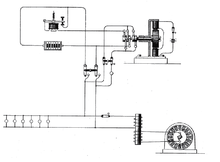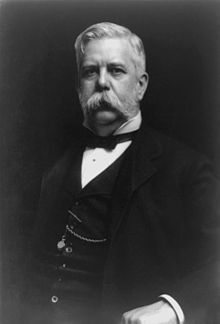George Westinghouse
George Westinghouse Jr. (October 6, 1846 – March 12, 1914) was a prolific American inventor, engineer, and entrepreneurial industrialist based in Pittsburgh, Pennsylvania.
Westinghouse Electric won the contract to showcase its AC system to illuminate the "White City" at the 1893 Columbian Exposition in Chicago.
The company went on to install the world's first large-scale, AC power generation plant at Niagara Falls, New York, which opened in August 1895.
Ironically, among many other honors, Westinghouse received the 1911 Edison Medal of the American Institute of Electrical Engineers "for meritorious achievement in connection with the development of the alternating current system".
After his discharge in August 1865, Westinghouse returned to his family and enrolled at Union College in Schenectady, but he quickly lost interest and dropped out during his first term.
Over the next two years, Westinghouse and his engineers addressed the problem by inverting the process, designing valves so that constant pressure in the lines kept the brakes disengaged.
In 1882, Westinghouse founded the Union Switch and Signal Company to manufacture, market, install, and maintain these innovative control systems, which were eventually adopted by railroads around the world.
Gas had recently been discovered in nearby Murrysville, Pennsylvania, and it attracted a lot of attention, in part because of a spectacular flaming blowout of the Haymaker Well in 1878.
After visiting the well and recognizing its commercial potential, he undertook drilling for gas on his estate Solitude (today's Westinghouse Park) in Pittsburgh.
Early in the morning of May 21, 1884, the drilling crew struck a pocket of gas at a depth of 1500 feet, and the resulting blast of dirt and water blew the top off the derrick.
By 1886, the Philadelphia Company owned 58 wells and 184 miles of distribution piping in the Pittsburgh area, and by 1887, it served over 12,000 private homes and 582 industrial customers throughout the state.
At the same time, Thomas Edison was launching the first DC electric utility designed to light homes and businesses with his patented incandescent bulb.
In 1884, Westinghouse began developing his own DC domestic lighting system and hired physicist William Stanley to help work on it.
Guido Pantaleoni, an Italian engineer in his employ, alerted Westinghouse to their already-patented transformer and a deployed system capable of transmitting electricity for many miles near London, Turin, and Rome.
[17] This innovation made it possible for large, centralized power plants to generate electricity and supply it over long distances to both cities and places with more dispersed populations.
Thomas Edison and his company joined and promoted a spreading public perception that the high voltages used in AC distribution were unsafe and deadly.
Westinghouse tried to block this move by hiring the best lawyer of the day to (unsuccessfully) defend William Kemmler, the first man scheduled to die in the chair.
[23] During this period, Westinghouse continued to pour money and engineering resources into the goal of building a completely integrated AC system — obtaining the Sawyer–Man lamp by buying Consolidated Electric Light, and developing components such as an induction meter,[24] and obtaining the rights to inventor Nikola Tesla's brushless AC induction motor along with patents for a new type of electric power distribution, polyphase alternating current.
The new lead lenders demanded that Westinghouse cut back on what looked to them like his excessive spending on the acquisition of other companies, research, and patents.
By the beginning of 1893, Westinghouse engineer Benjamin Lamme had made great progress in developing an efficient version of Tesla's induction motor.
It was a key event in the history of AC power, as Westinghouse demonstrated the safety, reliability, and efficiency of a fully integrated alternating current system to the American public.
Westinghouse and his engineers invented an automatic self-alignment system that finally made turbine power practical for large vessels.
Westinghouse was the first industrial employer in the United States to give workers a five-and-a half day work week, starting in June 1881.
All these accommodations, at Westinghouse's expense, were considered highly innovative at the time, especially in contrast to the conditions endured by workers in the nearby steel mills.
[48][49] An indication of his progressive attitude was that when Westinghouse engineers invented things, they were allowed to keep their names on the patents, though assigning rights to use them to the company.
[55] [56] A series of short movies showing conditions in and around Westinghouse factories was made in 1904 and exhibited at the St. Louis World's Fair.
By 1893, they had constructed Erskine Park in Lenox, Massachusetts, which they used as a summer home, in part as a respite from the gritty industrial environment of Pittsburgh.
In 1894, the Grand Army of the Republic, a fraternal organization of Union Civil War veterans, held a week-long convention in Pittsburgh.
He was a pioneer of imposing stature, one of the world's true noblemen, of whom America may well be proud and to whom humanity owes an immense debt of gratitude.
Many of the same inventions were also patented in foreign countries, including Austria, Australia, Canada, Denmark, France, Germany, Great Britain, Spain, and Switzerland.


















